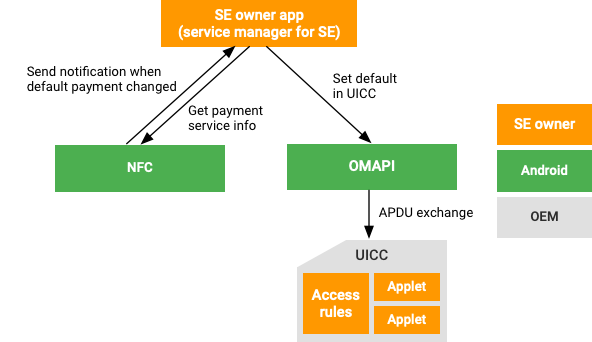Android hỗ trợ tính năng giả lập thẻ NFC bằng một phần tử bảo mật để giả lập thẻ ngoài máy chủ. (Để biết thêm thông tin, hãy xem phần Tổng quan về quy trình mô phỏng thẻ dựa trên máy chủ.) Tuy nhiên, trên nền tảng Android, dịch vụ thanh toán ưu tiên được chỉ định trong chế độ cài đặt Chạm và thanh toán không phải lúc nào cũng được đồng bộ hoá với ứng dụng trong phần tử bảo mật. Điều này có nghĩa là có thể một dịch vụ thanh toán không ưu tiên trong phần tử bảo mật sẽ được dùng thay vì dịch vụ thanh toán ưu tiên.
Trong Android 11, tính năng đồng bộ hoá thanh toán bên ngoài cung cấp một cơ chế cho phép bạn đồng bộ hoá cấu hình thanh toán trong tính năng Chạm và thanh toán, cấu hình định tuyến trên giao diện người dùng không tiếp xúc (CLF) và trạng thái do ứng dụng chọn trong phần tử bảo mật.
Sơ đồ sau đây minh hoạ cấu trúc thiết kế của tính năng đồng bộ hoá thanh toán bên ngoài máy chủ lưu trữ.

Triển khai
Để triển khai tính năng đồng bộ hoá thanh toán bên ngoài máy chủ lưu trữ, thiết bị phải có bộ điều khiển NFC hỗ trợ tiêu chuẩn NCI 2.0 và phải sử dụng các khung NFC và Giao diện lập trình ứng dụng di động mở (OMAPI) của Dự án nguồn mở Android.
Framework API
Để triển khai tính năng đồng bộ hoá thông tin thanh toán bên ngoài máy chủ lưu trữ, hãy sử dụng các API khung sau đây trong Dự án nguồn mở Android:
getAidsForPreferredPaymentService(): Truy xuất các AID (Giá trị nhận dạng ứng dụng) đã đăng ký cho dịch vụ thanh toán ưu tiên.getRouteDestinationForPreferredPaymentService(): Truy xuất đích đến của tuyến đường cho dịch vụ thanh toán ưu tiên.getDescriptionForPreferredPaymentService(): Trả về nội dung mô tả mà người dùng có thể thấy về dịch vụ thanh toán ưu tiên.android.permission.NFC_PREFERRED_PAYMENT_INFO(quyền): Cho phép các ứng dụng nhận thông tin về dịch vụ thanh toán ưu tiên qua NFC.android.nfc.action.PREFERRED_PAYMENT_CHANGED(thao tác truyền tin): Thông báo nếu dịch vụ thanh toán ưu tiên thay đổi.
Xác nhận kết quả
Để xác thực việc triển khai tính năng đồng bộ hoá thanh toán bên ngoài máy chủ lưu trữ, hãy cài đặt các ứng dụng phần tử bảo mật có các phần tử bảo mật tương ứng, sau đó kiểm tra các phản hồi thích hợp từ một đầu đọc NFC trong nhiều điều kiện.

